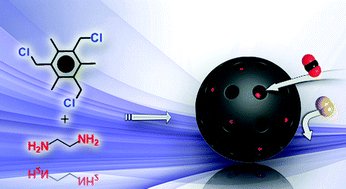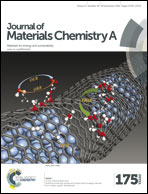Fabrication of nitrogen-doped porous carbons for highly efficient CO2 capture: rational choice of a polymer precursor†
Abstract
Because of the high stability, tailorable surface properties, and plentiful porosity, nitrogen-doped porous carbons (NPCs) are of great interest for CO2 capture. Carbonization of nitrogen-containing polymers is regularly utilized for the fabrication of NPCs, but such a method is obstructed by the high cost of some polymer precursors. Here we demonstrate the preparation of NPCs via the rational choice of a low-priced, nitrogen-rich polymer NUT-1 (NUT represents Nanjing Tech University) as the precursor, for the first time. The polymer NUT-1 was synthesized by the polymerization of two easily available monomers under mild conditions without the use of any catalysts. Carbonization at temperatures ranging from 500 to 800 °C leads to the generation of a series of NPCs possessing various porosity and nitrogen contents. The adsorption performance of NPCs is dependent on their pore structure and nitrogen-doped “CO2-philic” sites, while the sample with the largest surface area does not exhibit the highest adsorption amount of CO2. In the case of the material prepared at 600 °C (NPC-1-600), the CO2 adsorption amount can reach 7.5 mmol g−1 at 273 K and 1 bar, which is much higher than that of some benchmark materials, including 13X zeolite (4.1 mmol g−1) and activated carbon (2.8 mmol g−1), and most if not all reported carbon-based adsorbents. We also demonstrate that KOH plays an important role in the formation of abundant porosity. The reference material NPC-1-600r prepared in the absence of KOH can only adsorb 3.2 mmol CO2 g−1 at 273 K and 1 bar, which is obviously lower than its counterpart NPC-1-600 (7.5 mmol g−1). Our materials may offer to be promising candidates for carbon capture from gas mixtures including natural gas and flue gas.


 Please wait while we load your content...
Please wait while we load your content...